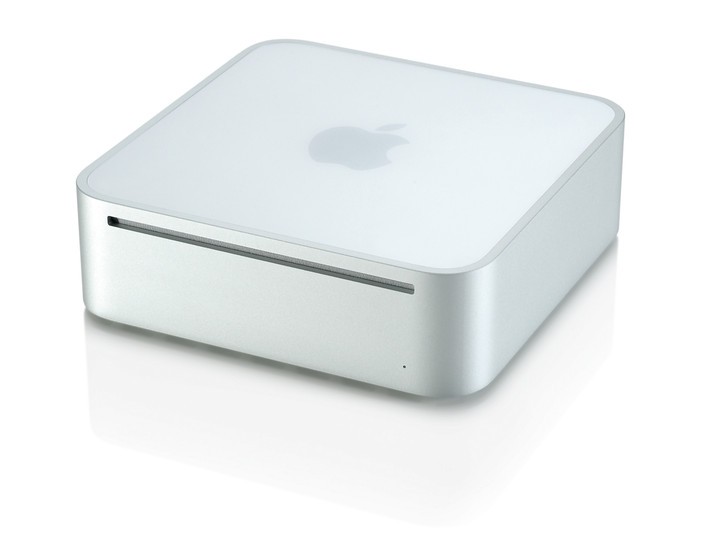TechRadar Verdict
Good value in Apple terms and a breakthrough in desktop miniaturisation. Essentially a laptop in a biscuit tin. Nice
Pros
- +
Superbly small
Upgradeable RAM
DVI out
Cons
- -
No keyboard or mouse
Lacks audio input
Slow hard drive
Why you can trust TechRadar
Some Mac commentators have claimed that Apple's newest baby is simply too low-spec for "proper use", whatever that term means. However, that's certainly not the impression we got when we had the chance to lay our hands on a 1.4GHz version of this sexy new entry-level Mac.
The first thing that strikes you is the mini's breathtakingly small dimension. It's no higher than five CDs in jewel cases and hardly any wider. It's light and comes packaged in a delightful cardboard box with a dainty plastic handle. Visually, it makes an impressive little parcel.
Shipping with the mini are two DVDs containing Mac OS X and Apple's Hardware Test software. You also get a power adaptor and a DVI to VGA plug for older monitors.
Our 80GB mini came preloaded with Mac OS 10.3.7, AppleWorks, Quicken 2005, Nanosaur 2 and Marble Blast Gold. That left us with around 65GB of free space on the 2.5-inch hard drive.
Control your iLife
Also lurking in the box is a copy of iLife '05. The full install takes up a lot of space, thanks to iDVD's gigabyte-guzzling setup. You can choose not to install iDVD, which might be a good idea if you don't have a SuperDrive.
And speaking of optical drives... the wafer-thin combo drive installed in our mini was very small but quite noisy. Like the optical drives fitted in all of Apple's laptops, it's a slot-loading type and flaps around making a din as it reads off data.
The drive's laptop behaviour reminds you just how much the mini owes its heritage to the iBook; after all, the mini is basically an iBook minus the screen and keyboard.
Sign up for breaking news, reviews, opinion, top tech deals, and more.
Both of the standard mini configurations come with 256MB of RAM installed in a single DIMM slot on the tiny square motherboard. Increasing the memory to 1GB of RAM costs £300 if you opt to upgrade at the time of purchase.
However, you can increase the RAM yourself later on for around the £150 mark if your buy your DIMM from a third-party such as www.crucial.com/uk (0800 013 0330). The great news, is that a DIY upgrade won't void your warranty - as long as you don't break anything while you're doing it, of course.
Getting to the RAM slot requires deft use of two putty knives in order to gently prise the bottom of the mini from its case. It's not too difficult, and doing it yourself will save you £150.
If upgrading the RAM manually worries you or sounds too expensive, then don't fret too much as the standard 256MB of RAM works reasonably well - thanks to OS X's memory management. It's not enough memory to edit a Hollywood movie or render in 3D, but it's surprisingly usable.
The Mac for switchers
Those switching to a mini from a PC can use their existing keyboard and screen, although if the keyboard is a PS/2 type you will need to get a convertor. Fortunately, a nice, brand-new Apple keyboard costs just £19 from the Apple store so that might be a better bet.
As far as noise goes the mini is wonderfully quiet, but as the load on the processor increases, the fan kicks in and makes a fair amount of noise. It's not deafening but it is a bit whiny.
When it comes to performance, the mini's reliance on its fairly slow laptop drive and sluggish 167MHz system bus means it's never going to be a Ferrari. This is the same sort of performance you get from the current PowerBook range and is more than adequate for most users. One small gripe, is that the power switch is around the back and there's no duplicated headphone socket on the front.
For general purpose use the new Mac mini is an elegant and highly serviceable piece of hardware. It represents excellent value for money in Apple terms and is so simple to set up and use. A bit more RAM would be handy and perhaps an easier way to upgrade to AirPort. Apart from that, we have to say that it's near perfect. Mark Sparrow
Tech.co.uk was the former name of TechRadar.com. Its staff were at the forefront of the digital publishing revolution, and spearheaded the move to bring consumer technology journalism to its natural home – online. Many of the current TechRadar staff started life a Tech.co.uk staff writer, covering everything from the emerging smartphone market to the evolving market of personal computers. Think of it as the building blocks of the TechRadar you love today.
